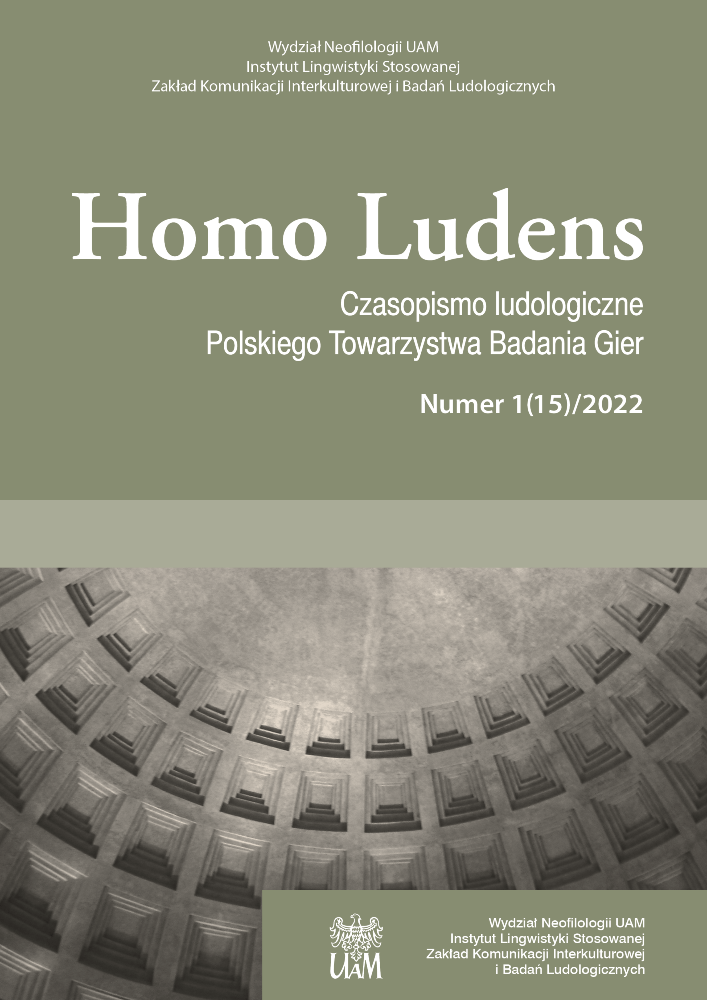Abstrakt
Artykuł skupia się na opisie nowego zjawiska w świecie gier wideo: popcorn gamingu. Poszukuje odpowiedzi na pytanie, dlaczego gracze decydują się na oglądanie gier wideo. Tekst odwołuje się do teorii komu-nikowania masowego Denisa McQuaila. Typ gracza nazywanego popcorn gamerem to w skrócie osoba, która woli oglądać gry niż w nie grać. Zjawisko popcorn gamingu ma zasadniczy związek z rozwojem platform oferujących funkcję streamingu – jak Twitch i YouTube – które przyczyniają się do powolnej zmiany nastawienia graczy do korzystania z gier.
Bibliografia
Bailey, C., Pearson, E., Gkatzidou, V., Green, S. (2006) Using Video Games to Develop Social, Collaborative and Communication Skills. Orlando.
Cheung, G., Huang, J. (201.1) Starcraft from the Stands: Understanding the Game Spectator. Proc. CHI 2011. ACM Press. DOI: https://doi.org/10.1145/1978942.1979053
De Kort, Y.A.W., IJsselsteijn, A., Gajadhar, B.J. (2007). People, Places, and Play: A Research Framework for Digital Game Experience in a Socio-Spatial Context. In Situated Play, Proceedings of DiGRA 2007 Conference. Online: <https://www.researchgate.net/publication/215827730_People_Places_and_Play_A_research_framework_for_digital_game_experience_in_a_socio-spatial_context>. Data dostępu: 29 listopada 2022.
Downs, J., Vetere, F., Howard, S. (2013). Paraplay: Exploring Playfulness around Physical Console Gaming. Proc. INTERACT 2013. Springer. DOI: https://doi.org/10.1007/978-3-642-40477-1_47
Gibbons, S. (2015). Disability, Neurological Diversity, and Inclusive Play: An Examination of the Social and Political Aspects of the Relationship between Disability and Games. Waterloo.
Goban-Klas, T. (2009). Media i komunikowanie masowe. Teorie i analizy prasy, radia, telewizji i Internetu. Warszawa: PWN.
Introducing Newzoo’s Gamer Segmentation™: The Key to Understanding, Quantifying, and Reaching the New Era of Game Enthusiasts (24 kwietnia 2019). Online: <https://newzoo.com/news/introducing-newzoos-gamer-segmentation-the-key-to-understanding-quantifying-and-reaching-game-enthusiasts-across-the-world/>. Data dostępu: 29 listopada 2022.
McQuail, D. (2008). Teoria komunikowania masowego. Warszawa: PWN.
Polański, G. (2017). Gratyfikacje z korzystania z mediów. Edukacja – Technika –Informatyka, nr 3, 250–255. DOI: https://doi.org/10.15584/eti.2017.3.35
Reeves, S. (2017). Designing Interfaces in Public Settings: Understanding the Role of the Spectator in Human Computer Interaction. London: Springer.
Stasieńko, J. (2005). Alien vs. predator? Gry komputerowe a badania literackie. Wrocław: Wydawnictwo Dolnośląskiej Szkoły Wyższej.
Rutkowski, E., Marszałkowski, J., Biedermann, S. (2020). The Game Industry of Poland. Online: <https://www.parp.gov.pl/component/publications/publication/the-game-industry-of-poland>. Data dostępu: 29 listopada 2022.
StreamElements, Arsenal.gg (b.d.). State of the Stream 2019. Online: <https://cdn.streamelements.com/static/State-of-Stream-2019.pdf>. Data dostępu: 29 listopada 2022.
Urbaniak, A. (2009). Kultura a język. Rola gier w rozwoju językowym współczesnego człowieka w świetle hipotezy Sapira-Whorfa. Homo Ludens, 1(1), 269–278.
Wroczyński, R. (1974). Pedagogika społeczna. Warszawa: PWN.
Zawadzka, A. (1976). Obciążenie studentów nauką a formy wypoczywania. Warszawa: PWN.
Złotek, M. (2017). Grywalizacja – wykorzystanie mechanizmów z gier jako motywatora do zmiany zachowania ludzi. Kraków: Oficyna Wydawnicza AFM.
Licencja
Prawa autorskie (c) 2023 Maciej Śledź

Utwór dostępny jest na licencji Creative Commons Uznanie autorstwa – Użycie niekomercyjne – Bez utworów zależnych 4.0 Międzynarodowe.
Szczegółowe informacje dotyczące prawa autorskiego zawarte są w umowie podpisywanej między wydawcą a autorem.
